Wednesday, November 30, 2011
Tuesday, November 29, 2011
Deer Camp

Opening day has varied meanings in different regions. To baseball fans it is the first pitch. To fly fisherman it is a morning on the stream.To Keystone state deer hunters it is the Monday after Thanksgiving when deer are hunted with rifles.For me, for many years, it is a trip to Deer Camp in Pike County and a cabin on a ridge above the Delaware river in Pennsylvania's northeast hardwood deer country.The experience and the memories begin during the drive. Beeches,Oaks and Hemlocks are framed black against the failing sun as you turn off Route 209.
When you drive off the paved road, there is the weathered grey wood sign "Camp Reform" bearing a carved outline of a high-powered rifle shell. The trucks and jeeps are parked in the wet leaves around the cabin and a dull yellow light pierces the Pocono darkness from the front window. Mounting the porch you see the jugs of spring water and the stacked cases of beer. The door always sticks so you give it a hard yank and you are met with the smell of cigar,woolen clothes,gun oil and the earnest greetings of the boys...your brethren,your hunting buddies. These are guys you went to college and law school with, as well as local old timers who grew up in and around Stroudsburg.In this cabin there is no pretense or posturing; just hunters gathered for a yearly pursuit of bucks and camaraderie unique to a hunting cabin.
At the table is Chick, 80 years old and still hunting. He wears the same black and red checked hunting cap, which is probably from a pre-war Woolrich catalogue and faded fatigue green khakis. He is fond of cranking up the wood stove and putting a galvanized pail of water on top.This arrangement gets the cabin sweltering like a botanist's hot-house...even though some years it is 60 degrees and raining outside. If you screw up and miss a shot, Chick will call you a Dutchman. He remembers guys who used to trap with your Grandfather. You covet his old deer rifle and feel privileged to talk to a sage old hunter of his wisdom and years. He says little but when he does speak we listen and it is either deer hunting wisdom or some damn funny story from a hunt 40 years back.
Benzley is at the table, a face and carriage like John Wayne and a Lucky Strike perched in his mouth. He is the Captain and you pay deference to his experience and woodsman's knowledge. He was a Marshall and a Sheriff and even in hunting clothes and a wrinkled orange cap has a distinct aura of law enforcment authority. He makes you feel welcome and will put you on a good deer stand the next morning because you are Jon's buddy from Lehigh. Benzley fries the eggs and scrapple in the morning and makes coffee that could erode a slab of Appalachian rock. He drops you off at a carefully selected deer stand in his old Chevy truck and leaves you in the cold dark morning with a wish for good luck and usually a remark about not missing.Benzley picks you up when the sun drops over the ridge and by that time of the late afternoon your cold toes and hands welcome the light glow of his headlights coming up the logginrg road.. He tells you where to watch for does and following bucks near a certain tree or stand of Rhododendron because he knows. Most of what you know about deer hunting comes from listening to Benzley and from hunting with him.
Roy stands up from the big table in the middle of the cabin and slaps your back. He asks how the goose hunting has been and wants to show you his new rifle...all the while hurling loving insults at Larry. Roy can drop a deer at 85 yards that is at a full run and put the lead projectile right in the "engine room" behind the front shoulder. Roy's wife has sent up 3 pans of lasagna for dinner. The sauce is from a jar and she uses too much ricotta...but it is filling and you eat 3 plates full out of respect. Roy can help you zero in your scope and knows the best loads for your .35 Remington for different stands where your shots are at varied distance and maybe thru thick brush.
Larry is the much loved and dumpy jester of the crew.His face is more Norman Rockwell hobo than anything else. He is in his early 70's and makes gag-inducing dandelion wine...but excellent syrup from a Maple sugarbush on his land.Larry's homemade scrapple is the best you'll ever get....made with buckwheat instead of cornmeal from a pig he kills every November. Larry has a bone saw in his garage and will butcher your deer for you.... a skill he learned in the woods but refined working at the A&P. He also dabbles in making "shine" and when you sit down, he hands you a "Veryfine" juice bottle of corn liquor that surprisingly has some color and age to it and hits the throat with less burn than you anticipate.The whiskey adds to the warmth of friendship you feel in the room. Larry is a guileless rural gentleman who asks questions about events in Philly and how the Eagles will make out. He is sure to remind you that Roy is a candy-ass and old Chick will out-hunt all of us and that John is getting uppity since being elected mayor and then Common Pleas Judge. Larry can shoot an acorn off an Oak at 100 yards and has great Navy stories. Larry used to be a bit wary because he figured you have money...but years of hunting together filed down that edge.
Jon is there at the table cleaning his .45 side arm. He carries this Colt revolver to his stand and swears one day he will drop a buck with it. A Lehigh and Law school classmate with a disarming smile,a wealth of charm and country wit and a surgical intellect and intelligence that he keeps well hidden at Camp...but unleashes on the County Bench in his role as Judge. He pitched for Lehigh,excelled in Law school and is engaged with passing to his sons the etiquette and ritual of Camp. Jon asks about the pheasant hunting, your wife and kids and makes his yearly excuse about missing the Lehigh v. Lafayette game. He spits his Skoal wad in a styrofoam cup and gets you up to date about his kids, his wife, County politics and where the deer are moving. Jon is the Co-Captain of the Camp and has killed his share of deer and knows these woods like a bookie knows the line on the Eagles/Cowboys game. Much of the ground we hunt on was taken from his grandfather by the Federal Government via eminent domain when they built the dam on the Delaware and created the Delaware Water-Gap National park. This affront still stings him and he is no fan of the Park Service or their intrusions. He knows I am from the Main Line but gives me a pass because I know what a "farmer's rain" is and because some of my people came to his County in the 1700's and because my Grandfather grew up in a house down the street from his and hunted and trapped these woods and rivers in the '20s, and because I know my way around a deer camp,and around these woods and around a duck blind and have a good bird dog of my own. You know Jon is one of the best guys you will ever know and you mentally kick yourself in the ass for not seeing him more often.
Bammer is another Lehigh crony who happens to live in New Jersey now and apologizes for it frequently. A broad shouldered ex-football player,he gives you a bear-hug and belts a shot of moonshine with you and makes sure you always have a fresh cold beer from the porch. Bammer makes the evening meal a sporting competition and can consume massive amounts of whatever is plated before him. He can drag a deer 2 miles through Pike County woods like a John Deere tractor and will always show up to help you gut and skin whatever deer you may shoot. He also expects and demands that I bring at least 2 of my Mom's Shoo-Fly pies. These are the wet-bottom variety that eclipse the cake-like junk fed to the tourists by the Amish down in Lancaster. These pies are from her great-grandmother's recipe and my Mom hits the ball over the fence every time she makes them. The pies are the first thing Bammer asks about after releasing the bear hug.Only after the pies have been produced from the truck does he ask about how things have been going since you last hunted together.
After dinner the Sunday night football game is flickering on a piece-of-shit 19 inch TV wedged in the corner. Smoke from the stove mixes with cigarettes and cigars and the stories and raunchy jokes pierce the humidity of Chick's water bucket heater contraption. Talk soon turns to where we will hunt the next morning and where the big bucks might be. A few hands of cards are played but the heat and the whiskey make you drowsy and you hit a bunk earlier than normal because you are getting up at 0-dark thirty. As you drift off and ignore the snoring and the creaking racks...you have a child's Christmas eve-like hope that you will clip the big buck the next morning. You inventory your hunting gear in your mind and the comfort and familiarity of deer camp is your last thought before sleep.
Monday, November 28, 2011
Stablemate

I have not spent much time reporting on the status of boxing endeavors as there has not been much to report. Things have changed dramatically. Specifically, our team has now signed a very exciting and talented young heavyweight. His name is Joey Cusamano and he hails from Virginia Beach. We have brought him up to North Jersey to train with Nelson Fernandez in preparation for a slate of fights beginning in late January. This kid is big,strong and possessed of blistering hand speed and serious athletic ability. He was 20-0 with 18 KO's as an amateur and 2-0 with 2 KO's as a pro so far...we hope and believe this is the one...the kid who can bring a heavyweight title back to the U.S.A. It will not happen overnight....but each journey begins with the first step.
Sunday, November 27, 2011
Theorbo-Dulcian-Viola Trio: Beautiful Performance; Beautiful Recordings
 E arly music trio last night at Deutscherordenkirche Wien was really excellent.
E arly music trio last night at Deutscherordenkirche Wien was really excellent.- Katharine Mandl, Fagott / Dulcian
- Elzbieta Sajka, Violetta / Viola da braccio
- Hermann Platzer, Theorbe
- Bartolomeo de Selma y Salaverde (1595-1638) - Canzon a due tenori (alto dulcian; viola da braccio; theorbo)
- Johann Hieronymus Kapsberger (1580-1648) - Toccata nona und Passacaglia für Theorbe Solo
- Adam Jarzębski (1590-1648) - Cantata Giovanni Gabrielli
- Selma y Salaverde - Sonata Vestiva i colli für Dulcian Solo (with Theorbo continuo)
- Jarzębski - Concerto secondo
- Alessandro Piccinini (1566-1638) - Toccata XII, Gagliarda III, und Chiaccona in partite variate für Theorbe Solo
- Giovanni Battista Fontana (1571-1630) - Sonata nona
- Philipp Friedrich Böddecker (1607-1683) - Sonata “La Monica”
D ulcian is a precursor to the modern bassoon. Ms. Mandl performed on two of them—a smaller alto one, plus a tenor one with a range similar to tenor sax. The trio achieved a fine balance and blending of the timbres of dulcian, 5-stringed violetta / viola da braccio, and theorbo (lute).
T he dulcian part in the Böddecker is amazingly ornate and fast—performed over a languid dotted-quarter/eighth/quarter/quarter viola melody, accompanied by the theorbo continuo. The neume-like notation (which Ms. Mandl explained and illustrated in her pre-performance talk) is prolifically dense in its own right; however, the improvisational cadenzas that Mandl applied took this far beyond the densely-notated score. Truly virtuosic bassoon—on this tender, very old instrument.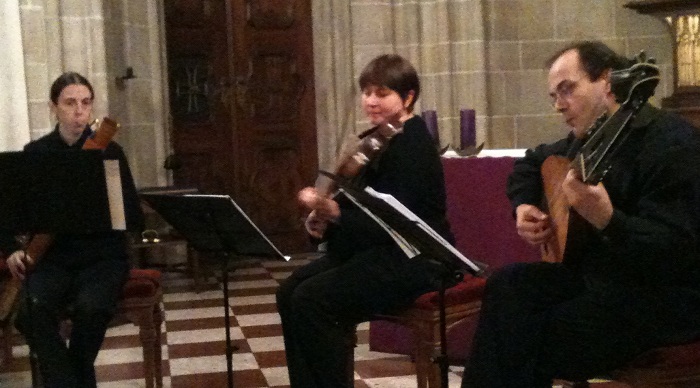 T he sanctuary at Deutschordenkirche is small and narrow—only about 10 meters wide. The consort last night positioned themselves near the altar, in a 60° circular-segment arrangement with chairs separated by about 1.5m. They recorded the performance using a Roland EDIROL R-44 4-channel digital recorder and two Schoeps MK-21 condenser microphones on a mic stand elevated 2.0m above the floor and angled downward 10° so that the mic axis of the left mic was midway between the dulcian and viola seats and the mic axis of the right mic was midway between the viola and theorbo seats. This distance to the instruments is a good compromise for these pieces—enough separation and directivity for the solo passages and appropriate lower-directivity for the tutti playing, so the listener’s attention is not confronted by unnatural left-right contrasts.
T he sanctuary at Deutschordenkirche is small and narrow—only about 10 meters wide. The consort last night positioned themselves near the altar, in a 60° circular-segment arrangement with chairs separated by about 1.5m. They recorded the performance using a Roland EDIROL R-44 4-channel digital recorder and two Schoeps MK-21 condenser microphones on a mic stand elevated 2.0m above the floor and angled downward 10° so that the mic axis of the left mic was midway between the dulcian and viola seats and the mic axis of the right mic was midway between the viola and theorbo seats. This distance to the instruments is a good compromise for these pieces—enough separation and directivity for the solo passages and appropriate lower-directivity for the tutti playing, so the listener’s attention is not confronted by unnatural left-right contrasts. T he wide off-axis response of this mic helps to blend adjacent instruments and enhance ensemble-ness. The 48-volt phantom-power Schoeps CMC-6 preamps (matched pair; one on each mic) are designed to be compatible with really long mic cables—as was the case last night with the EDIROL R-44 placed at one side of the sanctuary. The R-44 uses multi-gigabyte miniature camera-type SD cards or larger-capacity SDHC cards as the recording media and offers 24-bit wide A-to-D conversion and sampling frequencies (44.1KHz/48KHz/88.2KHz/96KHz/192KHz).
T he MK-21 Schoeps mics have a ‘subcardioid’ (wide cardioid) pattern—moderately high directionality and pretty flat frequency response. A pair of them currently costs about USD$3,500 new, and the R-44 is currently under USD$1,000. Mr. Platzer and Ms. Mandl easily set all the mics and recording equipment up within just two or three minutes before the program commenced, switched the EDIROL on, and so began the group’s performance: no muss, no fuss.
W e eagerly purchased 3 of the CDs that were available at last night’s performance (recordings made in 2007, 2009, and 2010, in Deutschordenkirche—which you can order off the group’s website [link below]). The sound imaging that they achieve with these nice mics and this set-up is phenomenally warm and detailed… heartily to be recommended to other early music groups who wish to capture high-quality sound of period instruments without tremendous worry or logistical troubles.
B ravo, for the live performance and for these excellent recordings!
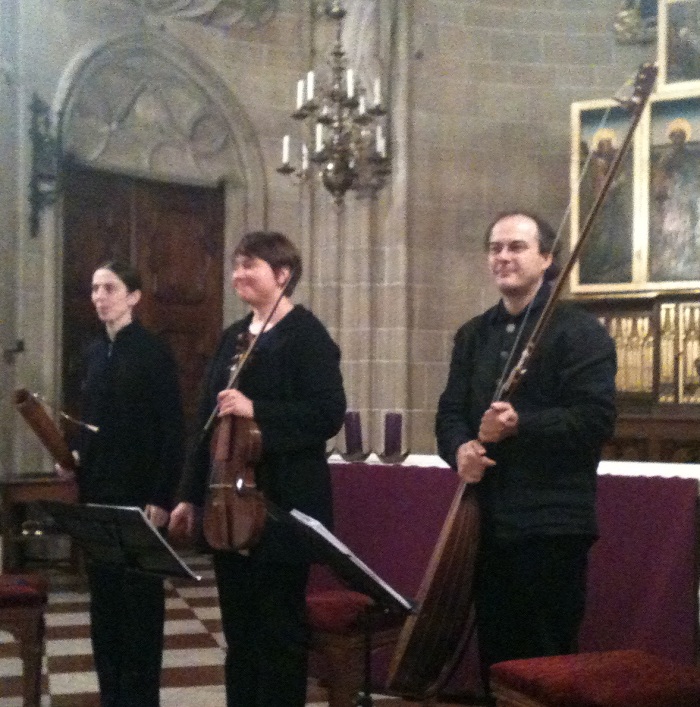
- Pandolfis Consort Wien website
- Piccini Chiaccona score at IMSLP
- Facsimile scores for 16th and 17th Century dulcian compositions at Dulcians.org (Hans Mons)
- Schoeps wide-cardioid mikes
- Roland EDIROL R-44 4-channel digital recorder
- Deutscherordenkirche Wien


Question Time with T-Bone
· Rhys Tubuscus Richardson
· Tom Hart
Schools above the Ground: Music of the Spanische Hofreitschule Wien
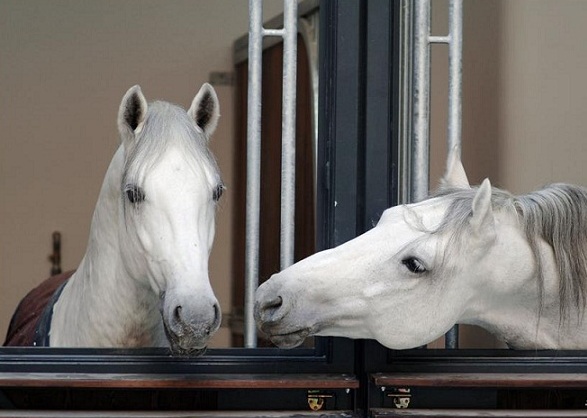 A n impressive performance this morning by Lippizaner horses and their riders at the Spanische Hofreitschule Wien. Such grace and rhythmic artistry by all!
A n impressive performance this morning by Lippizaner horses and their riders at the Spanische Hofreitschule Wien. Such grace and rhythmic artistry by all!- Favory Trompeta / Zimmermann
- Pluto Favorita / Oberhauser
- Pluto Medea / Burg
- Conversano Bellamira / Zimmermann
- Maestoso Beja I / Zeithofer
- Favory Gidrane / Egger
- Pluto Bellornata / Eder
- Neapolitano Gaetana / Rothleitner
- Conversano Undine I / Burg
- Maestoso Basowizza / Zimmermann
- Maestoso Calzedona / Eder
- Pluto Riga / Rothleitner-Schreiner
- Conversano Bonavoja / Zimmermann
- Favory Dagmar II / Oberhauser
- Maestoso Biondella / Burg
- Favory Duba / Zimmermann
- Favory Dagmar / Zimmermann
- Siglavy Recolta / Rothleitner
- Pluto Blanketta / Schreiner
- Conversano Darinka / Zimmermann
- Pluto Theodorosta / Oberhauser
- Favory Wanda / Burg
- Siglavy Dubovina II / Zimmermann
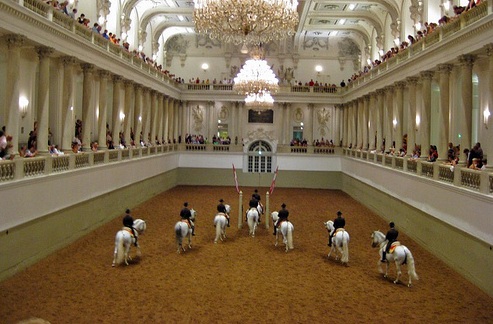
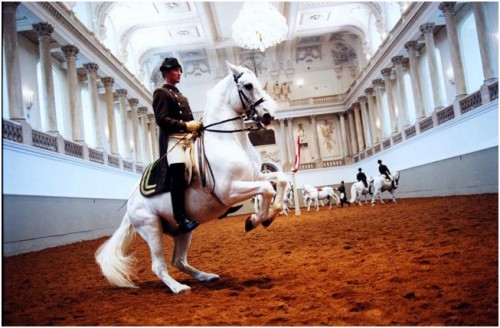
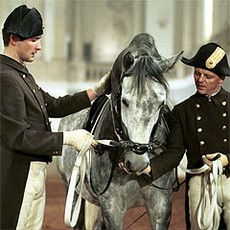 I nteresting to note that each rider generally trains and stays with each horse throughout the horse’s life after the horse comes to the SRS at age 4 to 6 years. Interesting, too, to note that the SRS riders are promoted from ‘Eleve/Elevin’ (apprentice/student) to ‘assistant rider’ level after not less than about 4 years.
I nteresting to note that each rider generally trains and stays with each horse throughout the horse’s life after the horse comes to the SRS at age 4 to 6 years. Interesting, too, to note that the SRS riders are promoted from ‘Eleve/Elevin’ (apprentice/student) to ‘assistant rider’ level after not less than about 4 years. P resenter Georgina Whittle gave animated and informative introductions to each of the 5 15-minute program segments, ending with the Schulequadrille.
- Schubert – Militärmarsch No. 1 in D major
- Schantl – Schmiedeck Fanfare
- Strauss (sohn) – Wiener Blut
- Boccherini – Menuett
- Schantl – Andrassy Fanfare
- Walch – Pariser Einzugsmarsch
- Ziehrer – Schönfeldsmarsch
- Fucik – Regimentskinder
- Bizet – Aus der Arlésienne Suite No. 2
- Chopin – Polonaise No. 1 in A major
- Haydn – Aus der Symphonie No. 101
- Traditional – Österreichischer Grenadiermarsch
- Strauss (vater) – Radetzky Marsch
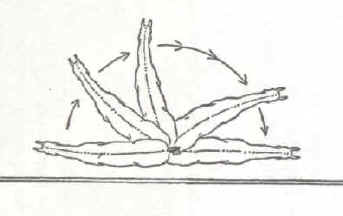
- Spanish Riding School (Spanische Hofreitschule Wien) website
- Lipizzanerkulinarium im traumhaften Ambiente des Barockschlosses Piber [fine dining with the Lippizaners behind your shoulder]
- Wienerisch Streichquartett. Lehar Franz: Pferdischer Quartetten. (Schmid, 2010.)
- Grebowicz M, Merrick H. Companion Species: Adventures with Donna Haraway. Columbia Univ, 2009.
- Haraway D. The Companion Species Manifesto: Dogs, People, and Significant Otherness. Prickly Paradigm, 2003.
- Fédération Equestre Internationale website
- U.S. Dressage Federation website
- ClassicalDressage.net

Saturday, November 26, 2011
Celebrating Advent & Christmas: Trumpet-Organ Duos

W hile rotary valve trumpets are not strictly speaking historical but rather contemporary brass instruments, trumpet players have in recent years increasingly been using these instruments for all of the Austro-German classical and romantic repertoire from Mozart and Haydn to Bruckner and Mahler... While the use of rotary valve instruments is certainly not historically accurate for the classical and early romantic natural trumpet orchestral literature, many conductors and players seem to feel that the tapered attack and warmer tone quality of these instruments is better suited to the modern performance of natural trumpet parts than the more brilliant and incisive piston valve instrument. There is no question, however, that the rotary valve trumpet is the stylistically appropriate and historically authentic instrument for the late 19th and early 20th century Germanic repertory.”T he Advent program at Annakirche in Vienna last night was excellent.
— David H. Green.
S tefan Fleißner (trpt) and Reinhard Schobesberger (organ) performed a 1-hour program for a delighted audience that completely filled the pews. The trumpet-organ duo works included arrangements of a number of Marienlieder, plus a variety of contemporary Christmas carols, plus the following:
- Clarke – Trumpet Fanfare, Prinz von Dänemark Marsch
- Haydn – Andante, Trumpet Concerto in E-flat major
- Marcello – Concerto in D minor
- Schubert – Ave Maria
- Telemann – Trumpet Concerto in D major
- Bach – ‘Jesu Joy of Man’s Desiring’, from Cantata ‘Herz und Mund und Tat und Leben’, BWV 147
- Torelli – Sinfonia in D major
T he rotary-valve keys have a shorter ‘throw’ (about 1 cm) than piston-valved instruments, so fingering of rapid passages may, in general, be a bit faster on these instruments, compared to on a conventional piston-valved trumpet. Other biomechanics advantages are mentioned by trumpet players who prefer these rotary-valve designs, including better symmetry between left-hand/arm and right-hand/arm musculature, in terms of holding the instrument… no brass crook for the right-hand “pinky,” and therefore no big forces on that little finger to get transmitted into the lumbricals of the other fingers of that hand; no tension in the left-hand; etc.
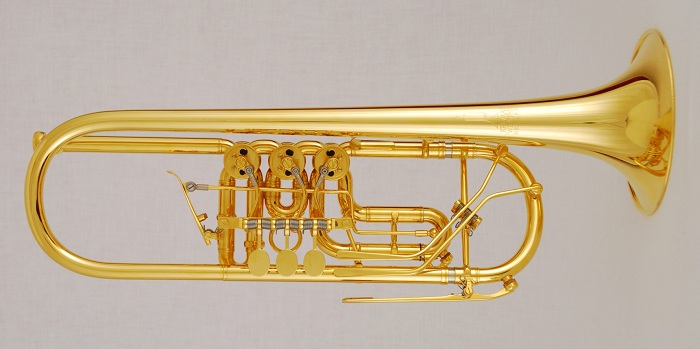 T he legato playing of Fleißner was superb throughout. Gorgeous, both in the sacred music and in the secular pieces.
T he legato playing of Fleißner was superb throughout. Gorgeous, both in the sacred music and in the secular pieces. 
- Schlagerl rotary-valve trumpets
- Ricco Kühn rotary-valve trumpets
- Weimann rotary-valve trumpets
- Thein rotary-valve trumpets
- Kuehnl-Hoyer rotary-valve trumpets
- Kromat rotary-valve trumpets
- Dotzauer rotary-valve trumpets
- Green D. A Player's Guide to Rotary Valve Trumpets. Antique Sound Workshop, 2002.
- Wiholm G, Campidell S. Valves and the microstructure of [brass] slurs. Institutes für Wiener Klangstil (Musikalische Akustik), 2009.
- Rotary valve maintenance page at Osmun.com
- TrumpetMaster.com
- TrumpetHerald.com
Friday, November 25, 2011
Claudia Bosse: Antiphonal Speech, Musicality of Eavesdropping

O ne can call this incestuous interplay of times a cacophony... Even, in analogy to the competition of generations, a competition among the texts emerges: i.e., the powerful ancient texts make - like unrestrained show-stoppers - the contemporary daily-life reports look pale. But this also means, that the frontal view distances the spectator, so he can feel comfortable. It is striking, that Bosse’s collage does not involve an immediate contemporary text; of all things, it is the present, that creates a blank spot on the "map of the present"- and of course it is exactly this blank spot that the audience has to occupy, to conquer, the eye of the needle for the audience to filter in. The frontality however blocks or contracts this hole in the overall picture, so that access is hindered or even refused. But, you can reopen this hole, precisely when the spatiality of the theatre is not concealed, when the force of the machinery producing its images is contantly interrupted as in Bosse's theatrical practices. This does not mean a return to cosmic salvation.”F ascinating sound-art installation by Claudia Bosse, currently in the Egon Schiele exhibit at the Leopold Museum in Vienna. The installation consists of a series of plate-glass kiosks that are just large enough to stand or sit in, dispersed in a nearly anechoic gallery room that has had foam applied to its walls.
— Sebastian Kirsch, 2011, review of Bosse’s ‘Vampires of the 21st Century’
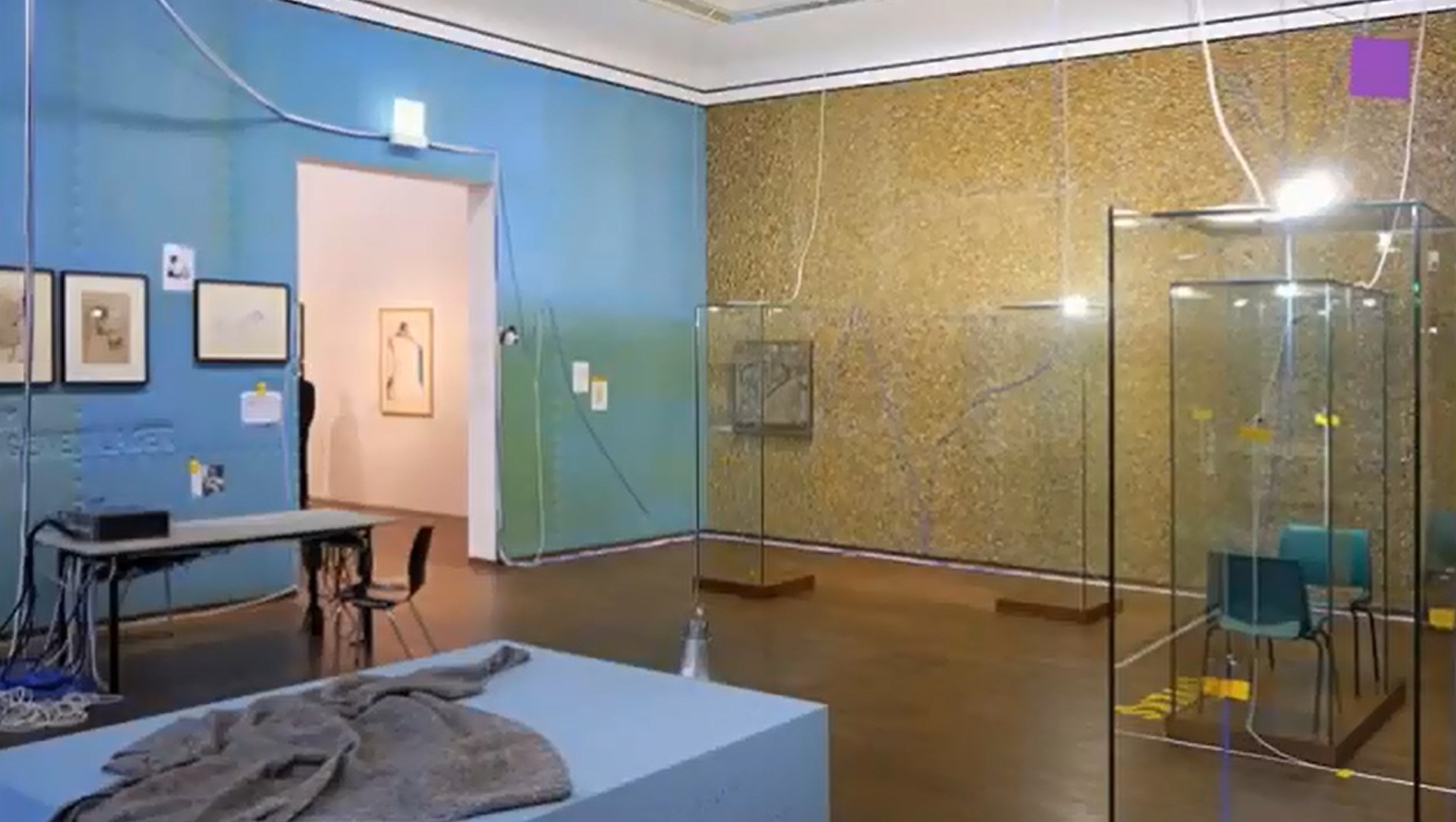
M ost of the glass compartments are large enough to hold only one person at a time (WxDxH: 50 cm x 80 cm x 200 cm). One that is labeled ‘LOVERS’ has two chairs in inside, with enough room for two people to sit facing each other.
S ome compartments have one miniature loudspeaker. Others have two or three of them, positioned at various spots high or low with respect to the vertical axis of the compartment. Some are positioned close to where your ears are located when you are inside the enclosure; others are far above, below, in-front-of-but-to-one-side, or behind your head. These speakers are 10 €, German-made Visaton® 36 mm diameter, 6 mm thick, 1 watt speakers—of the sort that might more usually be found in a laptop computer.

E ach speaker is fed by a pre-recorded, edited, pre-equalized track that is being played-back from a Alesis 24-track hard-disk recorder HD24

T he amplified outputs of the Alesis HD24 are fed via heavy twisted-pair shielded cables that are routed to each glass compartment and snaked up the plate glass walls. The naked black Mylar-cone speakers dangle from these wires—each cable end has been taped to the glass at the right height; the jacket and the wires’ insulation have been stripped; and the speaker has been soldered on, right there.
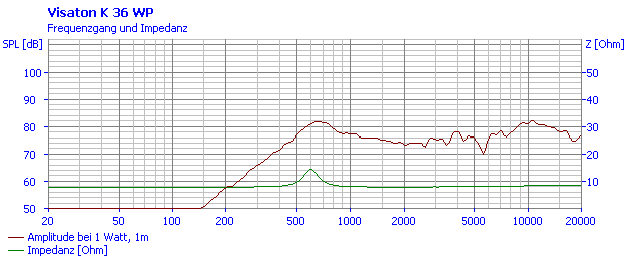
T he frequency response of these speakers is perfect for the frequency spectrum of the human voice, falling off rapidly below 300 Hz. The recorded tracks are entirely of women’s and men’s voices—either in conversation or in soliloquy. Some of the tracks seem to be spontaneous—‘found’ sounds, ambient bits of incidental speech that Ms. Bosse captured in public spaces. Other of the tracks have the measured phrasing of an actor reciting from a written script or poem or other text.
T he perfectly acoustically reflective plate glass surfaces of the booth interiors produce a listening environment where your ears experience a heightened awareness of directionality—an exaggerated sense of where the sound is coming from. In the ‘LOVERS’ kiosk, the speaker in the center is the most voluble—it is almost always saying something. It is the sound-source that both you and your partner seated in the booth can both hear consistently. The testimony from this central speaker provides the one account that you both can agree upon—a veridical, trustworthy narrator. But I cannot hear the second voice coming from the speaker that is positioned behind your head over there, nor can you hear the third voice from the speaker that is located above my left ear.
A t times I believe that the intermittent/interjecting voice behind my left ear is that of the person whose ‘public’ voice is heard coming from the center speaker, but into my left ear comes this text of reflection, reconsideration, interpretation—an internal dialogue that the person is having with herself, either contemporaneously with the ‘public’ discourse or at some time afterward. The fact that the speaker on the opposite side of the enclosure, behind your head over there, is probably interjecting interior, confessional, discorroborative utterances—maybe with far different emotional tone or factual content—concerns me. I want to talk to you about this after we leave this gallery. But the 5 minutes we spend inside that ‘LOVERS’ box covers too wide a range of ideas and rambling evidence for us to possibly remember, let alone remember accurately. How long does this multi-character ‘LOVERS’ collage continue before it reaches the end of its ‘loop’ and starts again? 20 minutes? 200 minutes?
T he poetical phrasing and sonic punctuations—not just of the more theatrical parts of it, but the ambient, found-sound parts as well—are a joy to hear: the exquisite quality of the multi-track recording and playback, crystal-clear. The musicality of the recorded, processed speech; the wonderful rhythmic design and orchestration of the recordings’ dovetailings with each other; the antiphonality or spatiality of it; the Henry Brant-esque “oblique harmonies” of it—and the intimacy of these small glass chambers, and the discourses that they enact—are all emblematic of what we mean by the term ‘chamber music’.
I have seen Alesis HD24 digital recorders used for recording musical ensembles before, but until now I have not seen them used for multi-track playback in sonic installation-art exhibits. This equipment is perfect for this purpose!
W hat you know and I do not know… What I know and you do not… What we both know; what we both doubt; what we both positively disbelieve... And what we see, through glass cubicles, other people knowing and doubting and disbelieving... The ‘transgressiveness’ of eavesdropping on other persons’ intimate conversations, inner lives, confessions—and the luxury of being ‘permitted’ to do this ad lib in an art gallery installation… The beauty of the artist’s gifting us with these insights that are ordinarily forbidden to us—or gotten only at expense of big, ugly guilty feelings.
- Claudia Bosse, theatercombinat
- C.R. Laurence & Co., frameless plate glass shower enclosure hardware
- Kim-Cohen S. In the Blink of an Ear: Toward a Non-Cochlear Sonic Art. Continuum, 2009.
- Kozloff S. Overhearing Film Dialogue. Univ California, 2000.
- Toop D. Sinister Resonance: The Mediumship of the Listener. Continuum, 2010.
- Films of Vienna Actionists
Post Thanksgiving Report

After a wonderful feast at the Sportsman'a home, featuring 15 for dinner and an 18 lb. free range turkey, it was off to the Duck Hunting Club. Of course, I helped with the clean-up chores before departure so we got to the Club fairly late.My wife and I worked hard on preparation and I was not going to bug out on the aftermath.
My companion was a buddy who now lives in Ohio and comes East for Thanksgiving with family in New Jersey. Our post turkey waterfowling has become a tradition of sorts. Carl is a great friend with a biting sense of humour and a love for the outdoors. Since his move we do not see each other enough but when we do, the whiskey supply is in peril, the conversation is intense, and the clack of pool balls is a constant.
We sat at the Club bar and enjoyed the Bourbon and cold beer, caught up about our kids, and then hit the racks.... a little too late given the early pre-dawn report required of duck hunters.
Friday dawned sunny and warm,too warm...a "blue-bird day" as the hunters say....NOT optimal waterfowling weather. No action to speak of in the A.M. and we adjourned to Helen's Famous Sausage house for a post hunt repast and to re-fuel for the afternoon expedition. After breaking out the pistols and cracking away at some bottles and cans for a while, we headed to the goose pit at about 3 P.M. and saw plenty of geese...just none that were interested in our spread of decoys. I believe they were resident, non-migratory birds that are quite wily and not easily duped by plastic injection molded facsimiles of themselves. We had numerous groups fly over and around; alas none were in range and none would lock up and commit. So as darkness fell and we were treated to a tremendous sunset, we unloaded and headed in for clean up and the trip back. The "middle" season ends tomorrow so we put up the shotguns until the season re-opens on December 7th. Until then, I am looking forward to a trip to Towson next Saturday to see Lehigh hopefully smoke Towson in the FCS playoffs.
Thursday, November 24, 2011
Seoyoung Lee/Heejung Hwang Cello-Organ Duo at St. Peterskirche in Wien
 I looked at the reading on my hiking compass: the temperature inside the church at 3:00 p.m. at the time of the concert by cellist Seoyoung Lee and organist Hee-Jung Hwang was just 10°C (50°F). Brrrr! But what surprising, atmospheric music it was. The cello voice projects perfectly in the sanctuary.
I looked at the reading on my hiking compass: the temperature inside the church at 3:00 p.m. at the time of the concert by cellist Seoyoung Lee and organist Hee-Jung Hwang was just 10°C (50°F). Brrrr! But what surprising, atmospheric music it was. The cello voice projects perfectly in the sanctuary.
H ow large can the literature for cello-organ duo be? Not too big, but due to composers’ increasing interest in it and several important recent commissions, the repertoire is growing.
F or a space as reverberous as St. Peterskirche, it’s important to keep the tempo slow—so the echoes have a chance to fade and not muddy what comes next. The meditative quality of the setting surely supports taking things at a slower-than-usual tempo anyway.
- David Bednall - Sonata
- Jean-Baptiste Breal - Sonate V in G-dur
- Gabriel Fauré - Elegie, Op. 24, Siciliennen, Op. 78
- Wilhelm Fitzenhagen - Resignation, Op.8
- Georg Goltermann - Andante religioso, Op.56
- Russell Hepplewhite - Invisible Landscapes
- Jean Huré - Air
- Theodor Kirchner - 2 Tonstücke, Op.92 for cello and organ
- Julius Klengel - Andante Sostenuto, Op.51
- Gustav Merkel - Ariosa, Op.55
- Serge Rachmaninoff - Vocalise, Op. 34, No. 14
- Camille Saint-Saens - Le Cygne
- Timothy Salter - Vitis flexuosa
- Oskar Wermann - Sonata for Cello and Organ, Op.58

Gogol’s Terminal Psychosis, No Effective Medical Palliative Care in Sight

I n the last stage of his life Gogol is increasingly consumed by a religious mania. He considers his past work a sin and burns the second part of his major novel, ‘Dead Souls’. In the end he refuses to eat. In his final hours he is visited by the fantastic figures from his own works – and they show themselves to be more reasonable than he is himself at this point. Gogol has utterly broken with his previous life and renounces it; now it is avenging itself. … This opera is not so much a biography as a poetic and satirical study of one of the greatest Russian writers, whose emotional life is as mysterious and fascinating as his idiosyncratic works... Lera Auerbach … has found her own voice, and it is full of stylistic freedom and dramatic power.”T he person must, according to the DSM-IV, have at least two out of five symptoms:
— Theater an der Wien opera, program notes, 2011.
- (i) delusions, (ii) hallucinations, (iii) disorganised speech, (iv) grossly disorganized or catatonic behavior, or (v) functional incapacities or negative symptoms (such as alogia, avolition, etc)—for a substantial percentage of a one month period;
- Plus, continuous signs of disturbance must continue for at least six months;
- Plus, substantial social or occupational dysfunction must be evident;
- Required exclusion criteria include substance abuse, mood disorder, and pervasive developmental disorder.
I f you are expecting in Lera Auerbach’s new opera a Gogolesque, cynical account of human nature, or about the ruling class (‘We are the 99%!’), or a scatology as absurdist art, you will not find it here.
N or will you learn famous Gogol’s concept of the untranslatable Russian word пошлость (‘poshlost’). [Vladimir Nabokov explained this as “posh-lust”, “not only the obviously trashy but mainly the falsely important, the falsely beautiful, the falsely clever, the falsely attractive” (Nabokov 1944, p. 70)—the falsely transcendent.] Пошлость reduces reality to a sort of cavalier mediocrity and unrepentant vulgarity—a moral and spiritual condition from which humankind cannot escape—compulsive smutiness, radical pointlessness, compulsive garish carnival, absurd superfluousness.
N o, in this fantastical new opera we get nonstop existential angst and horror—superbly manifested in Auerbach’s score and libretto, and in an exceptionally fine production by Theater an der Wien (who commissioned the work), with performances by ORF Radiosymphonieorchester, Arnold Schoenberg Chor, Grazer Kapellknaben, and Mozartknabenchor Wien… a convincing reenactment, showing the suffering Gogol, receiving no effective medical help for his end-of-life psychiatric condition.
I t is as though Gogol’s invention, пошлость, ironically haunted him during his final days. Which amounts to a lesson to us all, to be careful about what we dream, what we think, what we dwell upon. As our minds begin to fail late in life, those one-time droll ideas of ours—every hubristic preoccupation; every cynical mental posture we ever indulged—every one of them could become real in our waning days—and we may be powerless to make them stop from bothering us. Bad karma or poetic justice, hunting you down in your own lifetime! Ein Alptraum jagt den nächsten!B efore writing a note of ‘Gogol,’ composer Lera Auerbach immersed herself in the writer’s complete works and over twenty books written about him. It would take similar efforts to begin to understand this opera: taking us inside the fevered mind of its title character, ‘Gogol’ is less a biographical narrative set to music than a phantasmagorical, psychological investigation. Given a virtuosic staging by director Christine Mielitz, it is also an overwhelming theatrical experience.” — Zwölftöner (Werner Kmetitsch), 17-NOV-2011.A uerbach regularly collaborates with soloists and ensembles including Hilary Hahn, Vadim Gluzman, Leonidas Kavakos, Julian Rachlin, Philippe Quint, Gautier Capuçon, Alisa Weilerstein, David Finckel, Kim Kashkashian, Tokyo String Quartet, Borromeo Quartet, Artemis String Quartet, Vanbrugh String Quartet, Kremerata Baltica, Camerata Pacifica, and the Chamber Music Society of Lincoln Center. Auerbach was born in the city of Chelyabinsk, adjacent to Siberia. After writing her first opera when she was 12, she moved to the U.S. in 1991 where she studied piano and composition at Juilliard. Her piano studies took her to the Hochschule für Musik und Theater in Hannover. She was awarded the Hindemith Prize by the Schleswig-Holstein Musik Festival in Germany, Deutschlandfunk’s Förderpreis, selected as a Paul and Daisy Soros Fellow, and in 2007 she was selected as a member of the Young Global Leaders forum by the World Economic Forum in Davos, Switzerland.

- Lera Auerbach website
- Theater an der Wien ‘Gogol’ production
- 'Gogol' at ORF.at [good pix here]
- Nikolai Gogol (1809-1852) page at Wikipedia
- Aleccia J. Before Code Blue: Who’s minding the patient? Little-known ‘failure to rescue’ is most common hospital safety mistake. MSNBC, 08-APR-2008.
- Allen E. A Fallen Idol Is Still a God: Lermontov and the Quandaries of Cultural Transition. Stanford Univ, 2006.
- Arkhangel'skii G. The medical environment of N. V. Gogol. Klin Med (Mosk). 1985;63:138-41.
- Bennett M. Reassessing the Theatre of the Absurd. Palgrave-Macmillan, 2011.
- Fanger D. The Creation of Nikolai Gogol. Belknap, 1979
- Friedlander M, et al. Delirium in palliative care. Oncology. 2004;18:1541-50.
- Fusso S, Meyer P, eds. Essays on Gogol: Logos and the Russian Word. Northwestern Univ, 1994.
- Geppert C, et al. To treat or not to treat: Psychosis, palliative care, and ethics at the end-of-life. Psychosomatics. 2011;52:178-84.
- Kmetitsch W. Review. Von heute auf morgen, 18-NOV-2011 [good pix here]
- LeFevre P, et al. Screening for psychiatric illness in the palliative care in-patient setting. Palliat Med. 1999;13:399-407.
- Milne L, ed. Reflective Laughter: Aspects of Humour in Russian Culture. Anthem, 2004.
- Nabokov V. Nikolai Gogol. New Directions, 1944.
- Orwin D. Consequences of Consciousness: Turgenev, Dostoevsky, and Tolstoy. Stanford Univ, 2007.
- Rasmussen K, Richardson J. Electroconvulsive therapy in palliative care. Am J Hosp Palliat Care. 2011;28:375-7.
- Witztum E, et al. Creativity and insanity: The enigmatic medical biography of Nikolai Gogol. J Med Biogr 2000;8:110-6
G ogol’s ‘grotesque’ is a—] means of estranging—a comic hyperbole that unmasks the banality and inhumanity of ambient reality.” — Susanne Fusso, p. 69.